![]()

Vintage 19” Patsy Ann doll
Patsy Ann was first introduced in June 1929, just months prior to the Stock Market crash in October. She followed the success of her smaller (14”) sister Patsy. These were the first two dolls in what came to be the Patsy family dynasty. These well-made dolls were enormously popular, not only surviving hard times but flourishing. Patsy Ann is just one member of this large doll family. This is her story.
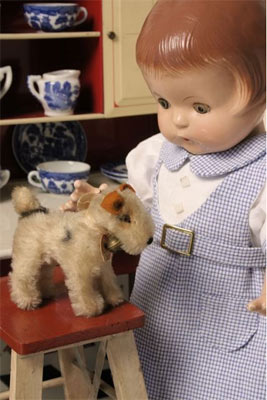
Dolls give us an interesting glimpse of the world at a particular place and time. With her serious expression and no-frills appearance, Patsy Ann seems to mirror some of the cultural changes that were occurring in the first half of the 20th century as women gained in power and status.
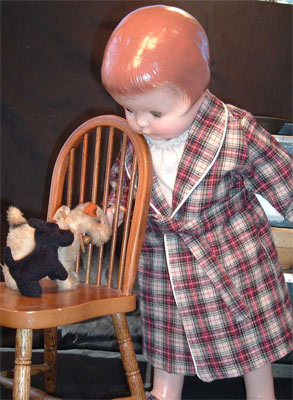
A Look in Her Closet
While dolls in their original attire are most desirable to collectors, many old dolls have none left, hence the need for replaced clothing. The outfits in this website, with a couple of noted exceptions, are my own work.
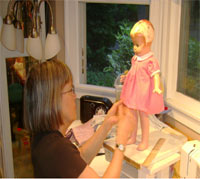
I’ve used vintage patterns and also sometimes designed my own variations. I’m always watching for the unexpected – from mother-of-pearl baby buttons at the Brimfield Antique Textiles Show to vintage linens hidden in family closets. Photo above shows my studio.
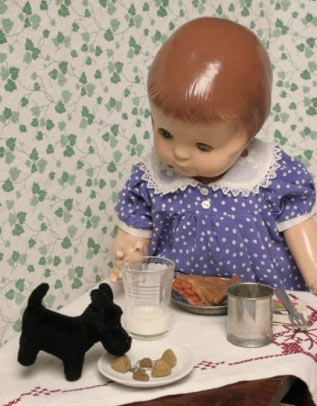
The Patsy dolls were meant to look like ordinary children. Their appearance was so popular that it was often copied by other companies. This extended world-wide, with French imitation Patsy dolls produced in celluloid and German look-alikes in bisque.
To keep the line fresh, new family members were added through 1936. Although they were sold into the 1940s, their greatest popularity was during the ‘30s.
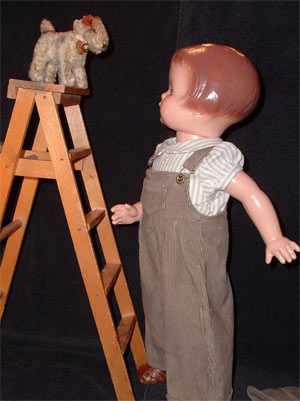
Her Beginnings
It was Bernard Lipfert, a Brooklyn doll sculptor, who created the Patsy dolls. Mr. Lipfert worked as a freelance artist, selling his work to many doll companies during his long career. The Effanbee Doll Company produced the Patsy dolls and this collaboration, between artist and manufacturer, proved to be a fruitful one for many years.
Mr. Lipfert was born in 1886, emigrating from Germany to New York City. He was a prolific sculptor and worked out of his Brooklyn basement and later in his home on Long Island
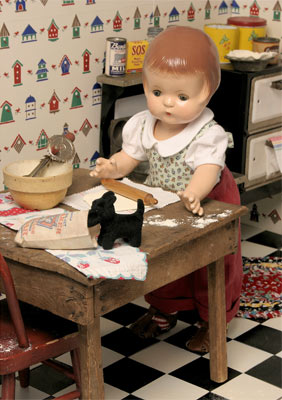
According to his family, Mr. Lipfert was a modest, unassuming man, who occasionally enjoyed a pinochle game at the kitchen table with Beatrice Alexander Behrman, the creator of the Madame Alexander dolls.
He kept a bride doll standing in the grandfather clock at home, but no others on display, in spite of the renown of his creations.
Bernard Lipfert is responsible for many popular 20th century dolls, including Toni, Shirley Temple and Betsy McCall. It’s said that he considered the Patsy dolls his finest work. He died in 1974.
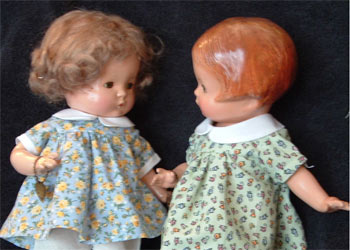
First Patsy (14”)
This was the first size Patsy doll made. She came on the market in late 1927 with the name Mimi. The name was soon changed to Patsy, for the daughter of the famed Irish aviator, James Fitzmaurice, as flight was the rage of the day. Most of the Patsy dolls had molded hair in a “bob”. Wigged versions were added for variety.
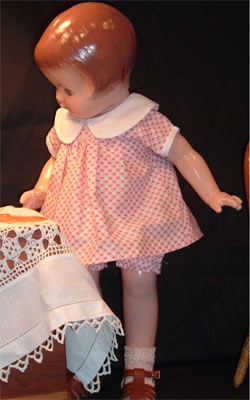
19” Patsy Ann Was Next
She was supposed to be Patsy’s big sister. She was described as “impish” looking in trade magazines at that time. The Patsy dolls range in size from the smallest, 6” Wee Patsy, to the tallest, 30” Patsy Mae.
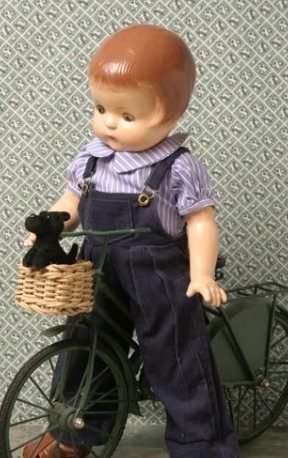
Selling Patsy Ann
The first Patsy Ann dolls sold for about five dollars. The Depression necessitated some creative marketing. Some ads from the ‘30s feature offers of a Patsy Ann for the purchase of a newspaper subscription or for opening a bank account.
Among other marketing innovations were a Patsy doll club sponsored by Effanbee and an “Aunt Patsy” who promoted the dolls by visiting department stores.
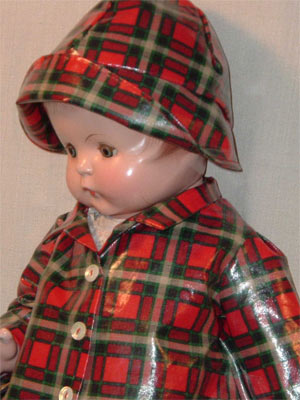
Composition Dolls
The Patsy dolls were made of a material called composition. Composition is mostly a mixture of wood pulp and glue. Manufacturers added other ingredients according to their own unique recipes. The dolls were then painted. Composition dolls have a warm glow to them.
“Compo” dolls were eventually supplanted by the hard plastic dolls common by the 1950s.
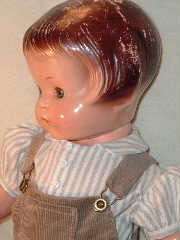
Durability
People at the time thought that composition dolls were very durable, since they followed the use of materials like bisque or wax. We now know that’s not true. A lot of the Patsys have composition that has lifted or split as well as chipping paint.
The “paint rubs” on the hair of this Patsy Ann are typical of dolls this old.
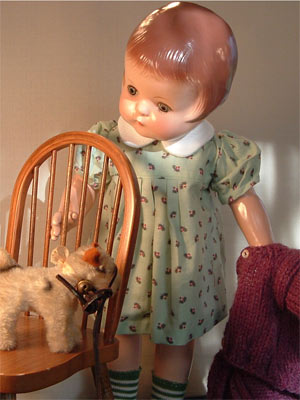
Dress Made from a Pattern of the 1930s
A lot of original clothing didn’t survive well since fabric often ages faster than the dolls themselves.
The Patsy family had clothing and wardrobes that were sold in addition to the dolls. At the time, this was a novel idea that promoted sales throughout the year, not just at the holidays. Clothing patterns were also developed by the major companies for home sewing.
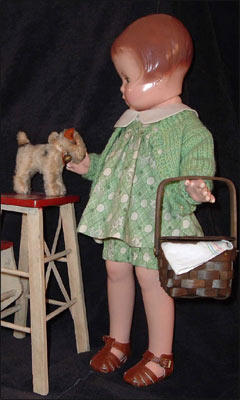
Styles of the 1930s
Her outfit is called a “bloomer frock”. This is what girls of her age and time might have worn. If the dress fabric was scratchy or thin, then a “combination suit” would have replaced the bloomers. The coordinating bloomers or combination were meant to show below the short dress.
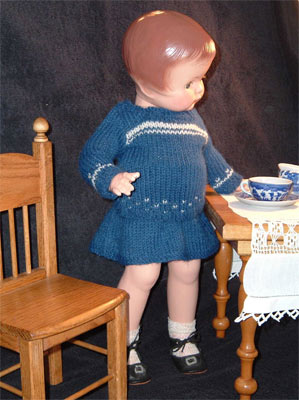
A sweater like this would have been called a “jumper” in her day. These shoes are original. You can tell by the style, condition and the small buckles on them.
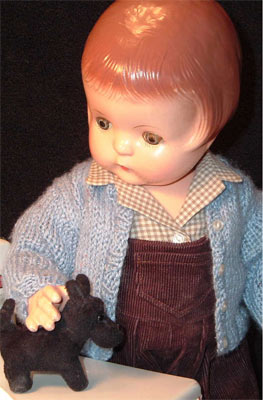
Her bent right arm makes her look less stilted and more life-like. She can pose easily and stand up on her own.
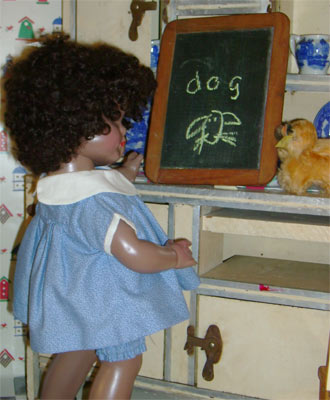
Scene from
Wenham Museum Exhibit
Vintage composition African-American Patsy Anns are rare and this is a special doll indeed. She has been restored, which lessens her appeal to some collectors. But when needed and done well, restoration may perhaps preserve a vintage doll for future generations.
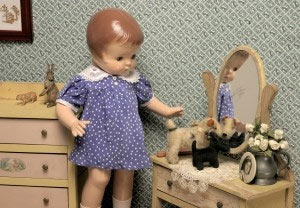
Patsy Ann with Period Furniture
These pieces are not original to her. Most are vintage toys from the 1920s-1940s. The small round photo shows my mother-in-law as a child in the 1930s. The lace-edged collar of this dress is made from one of her old elegant handkerchiefs.

Cooking with Tootsie and Rascal
Although terriers were popular at the time, her dogs are my addition – just for fun.
Her apron is made of an old feed sack that says “Quaker Sugar”. Feed sack fabric is in high demand with collectors and quilters today.
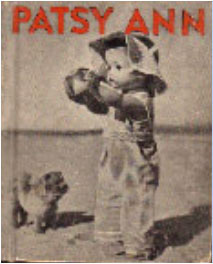
Her Book
Patsy Ann even had her own book. Patsy Ann, Her Happy Times was published in 1936 by Rand McNally. Written by Mona Reed King, it chronicled a year in Patsy Ann’s life using charming black and white photographs by G. Allan King. Old copies of the book are sought after by collectors of Patsy family memorabilia.
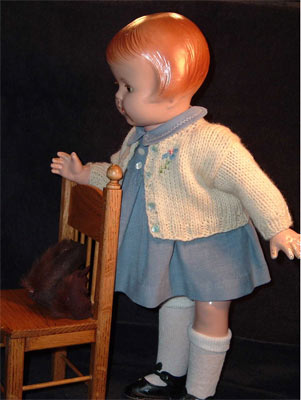
22” Patsy Lou
Patsy Lou is another Patsy family member. She is a bit taller, and although her profile resembles Patsy Ann, her face has a more pensive look.
Her visibility was boosted when she appeared in ‘30’s press photos with high profile figures, like Shirley Temple and Eleanor Roosevelt.
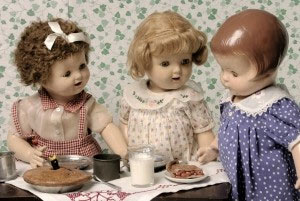
Patsy Ann with
Extended Family
These are some of the dolls that had Patsy bodies but different heads and often had wigs. They were called “variants”. Betty Brite (left) has a lamb skin or “tousle” wig and is in her original clothing. Mary Ann (middle) has a mohair wig and a homemade dress from the 1930s.
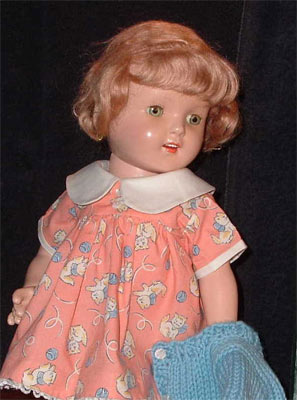
This is the same Mary Ann doll seen in the photo above. This picture shows what unusually clear green eyes she has. Often the eyes of these old dolls cloud over.
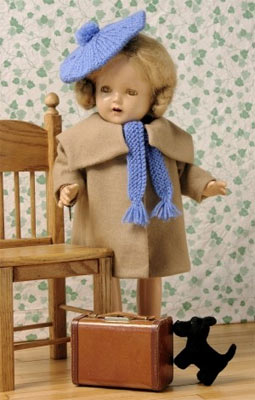
16” Mary Lee
Mary Lee is a variant of Patsy Joan, another Patsy family doll. Her eyes are cloudy and her paint is a bit faded, but otherwise she is in very good condition. Her hair is in its original set, which probably means she wasn’t played with very much.
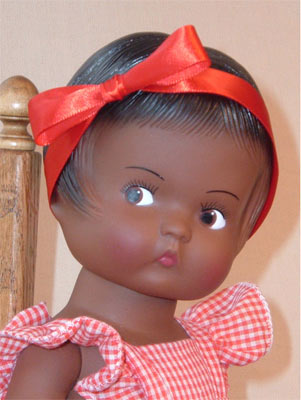
Newer Patsys
This 14” reproduction Patsy is a 1986 version of the old composition doll and is wearing factory-made clothing. She is made entirely of vinyl and has painted “side-glancing eyes”.
Nowadays, the Tonner Doll Company owns Effanbee. They continue the Patsy Ann tradition – producing a slightly shorter Patsy Ann™ than the original 19” composition one.
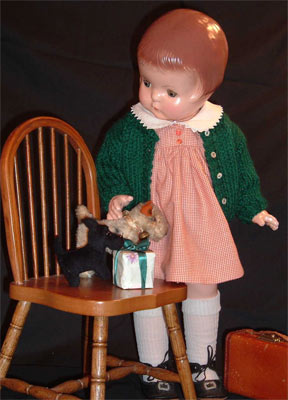
A Milestone
Patsy Ann celebrated her eightieth birthday in June 2009. She still looks at the world with that same earnest and wistful expression. While she emerged from a time that seems far removed from ours today, it is perhaps that simple charm that woos us still.
References
All Dolls Are Collectible, by Genevieve Angione and Judith Whorton, Crown Publishers, 1977.
Dolls and Accessories of the 1930s-1940s, by Dian Zillner, Schiffer Publishing Ltd., 2002.
How to Make Children’s Clothes, by Singer Sewing Machine Company, Inc., 1930.
Ideal Dolls, by Judith Izen, Collector Books, 2005.
Patsy Doll Family Encyclopedia Volume 1, by Patricia N. Schoonmaker, Hobby House Press, 1992.
Sewing for 20th Century Dolls, by Johana Anderton, Hobby House Press, 1972.
A Stitch in Time – Knitting & Crochet Patterns of the 20s, 30s & 40s, by Jane Waller, Chilton Book Co., 1972.
The Toy and Game Inventor’s Handbook, by Richard Levy & Ronald Weingartner, Alpha (Penguin Group) 2003.
Any inaccuracies are entirely my own.





